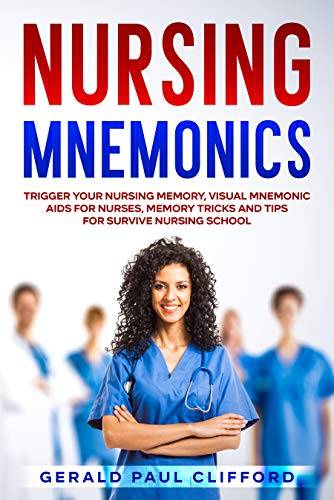

Nursing Mnemonics: Trigger Your Nursing Memory, Visual Mnemonic Aids for Nurses, Memory Tricks and Tips for Survive Nursing School
by Gerald Paul Clifford
Are you studying to become a nurse? Are you planning to take the NCLEX exam? Are you finding it difficult to remember all of the facts and specific medical information required of you for this position?
If you answered yes to any of these questions, then this is the book for you.
Inside you will find:•Information on the proven memory aid of mnemonics, including how they work so that you can even make up your own.
✓ Hundreds of medical mnemonics cover many different topics that will help you remember the facts for exams and your daily work as a nurse.
✓ Information on the NCLEX exam, including what to expect and how to study for this important exam.
✓ 100 practice questions and answers in the same format that you will find on the NCLEX exam to know exactly what to expect.
•Do you know off the top of your head when you should be concerned about a patient’s mole?
If you remember the mnemonic ABCDE, then it will be easy! •A = Asymmetry• B = Border irregular• C = Color irregular• D = Diameter usually greater than 0.5 cm• E = Elevation irregularWhat if you are looking at an x-ray and notice something weird that shouldn’t be there.
If you see HOLES in the chest, that is WEIRD. What are the possible differentials?•W = Wegner’s syndrome•E = Embolic (pulmonary, septic)•I = Infection (anaerobes, pneumocystis, TB)•R = Rheumatoid (Necrobiotic nodules)•D = Developmental cysts (sequestration)•H = Histiocytosis•O = Oncological•L = Lymphangeioleiomyomatosis•E = Environmental/ occupational•S = Sarcoid.
Like in these examples, mnemonics are a proven way to help you recall specific information, including detailed information such as differentials, symptoms, diagnostics, and even steps in a procedure. Throughout this book, you will find hundreds of mnemonics, many of which have been used for years by health care professionals to help them recall vital information. Once you see how the mnemonics work, you can pick and choose the ones that work for you, or you can even use the information in this book to create your own mnemonics that are easy for you to remember.
Mnemonics can also come in handy on the NCLEX. Here is a question that is typical for this exam:
A patient comes to the clinic complaining of severe gastrointestinal distress. Which abdominal physical assessment step does the nurse do first?
a.Inspection b.Palpation c.Percussion d.Auscultation.
If you remember your mnemonic tricks, then this question will be easy. Remember the mnemonic “I Am a People Person,” and you will instantly know that the answer is “A, inspection.”
•I = Inspection•A = Auscultation•P = Percussion•P = Palpation.
Please don’t wait until you are studying for exams, pick up this book, and use it throughout your studies so that the mnemonics used will become second nature to you and propel you towards your nursing career.
If you answered yes to any of these questions, then this is the book for you.
Inside you will find:•Information on the proven memory aid of mnemonics, including how they work so that you can even make up your own.
✓ Hundreds of medical mnemonics cover many different topics that will help you remember the facts for exams and your daily work as a nurse.
✓ Information on the NCLEX exam, including what to expect and how to study for this important exam.
✓ 100 practice questions and answers in the same format that you will find on the NCLEX exam to know exactly what to expect.
•Do you know off the top of your head when you should be concerned about a patient’s mole?
If you remember the mnemonic ABCDE, then it will be easy! •A = Asymmetry• B = Border irregular• C = Color irregular• D = Diameter usually greater than 0.5 cm• E = Elevation irregularWhat if you are looking at an x-ray and notice something weird that shouldn’t be there.
If you see HOLES in the chest, that is WEIRD. What are the possible differentials?•W = Wegner’s syndrome•E = Embolic (pulmonary, septic)•I = Infection (anaerobes, pneumocystis, TB)•R = Rheumatoid (Necrobiotic nodules)•D = Developmental cysts (sequestration)•H = Histiocytosis•O = Oncological•L = Lymphangeioleiomyomatosis•E = Environmental/ occupational•S = Sarcoid.
Like in these examples, mnemonics are a proven way to help you recall specific information, including detailed information such as differentials, symptoms, diagnostics, and even steps in a procedure. Throughout this book, you will find hundreds of mnemonics, many of which have been used for years by health care professionals to help them recall vital information. Once you see how the mnemonics work, you can pick and choose the ones that work for you, or you can even use the information in this book to create your own mnemonics that are easy for you to remember.
Mnemonics can also come in handy on the NCLEX. Here is a question that is typical for this exam:
A patient comes to the clinic complaining of severe gastrointestinal distress. Which abdominal physical assessment step does the nurse do first?
a.Inspection b.Palpation c.Percussion d.Auscultation.
If you remember your mnemonic tricks, then this question will be easy. Remember the mnemonic “I Am a People Person,” and you will instantly know that the answer is “A, inspection.”
•I = Inspection•A = Auscultation•P = Percussion•P = Palpation.
Please don’t wait until you are studying for exams, pick up this book, and use it throughout your studies so that the mnemonics used will become second nature to you and propel you towards your nursing career.

